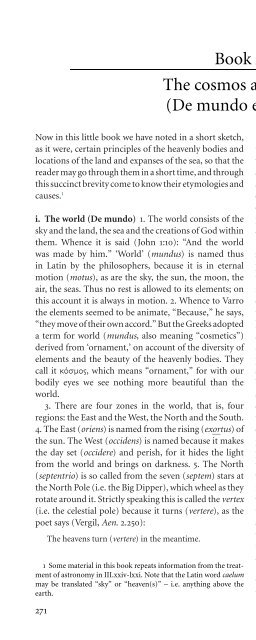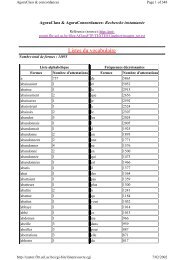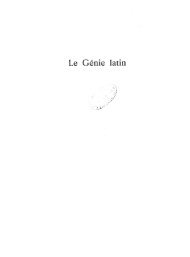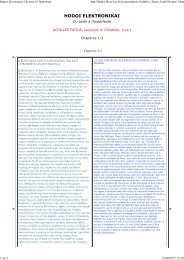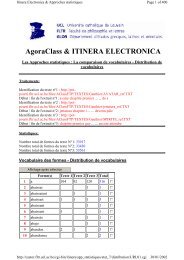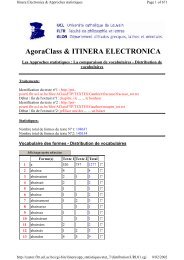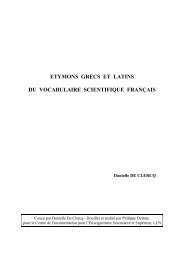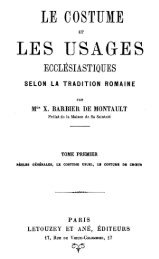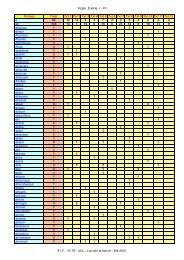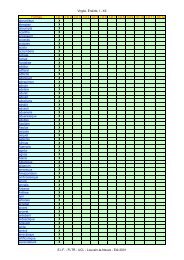The Etymologies of Isidore of Seville - Pot-pourri
The Etymologies of Isidore of Seville - Pot-pourri
The Etymologies of Isidore of Seville - Pot-pourri
Create successful ePaper yourself
Turn your PDF publications into a flip-book with our unique Google optimized e-Paper software.
Now inthis little book we have noted in a short sketch,<br />
as it were, certain principles <strong>of</strong> the heavenly bodies and<br />
locations <strong>of</strong> the land and expanses <strong>of</strong> the sea, so that the<br />
reader may go through them in a short time, and through<br />
this succinct brevity come to know their etymologies and<br />
causes. 1<br />
i. <strong>The</strong> world (De mundo) 1. <strong>The</strong>worldconsists <strong>of</strong> the<br />
sky and the land, the sea and the creations <strong>of</strong> God within<br />
them. Whence it is said (John 1:10): “And the world<br />
was made by him.” ‘World’ (mundus) isnamedthus<br />
in Latin by the philosophers, because it is in eternal<br />
motion (motus), as are the sky, the sun, the moon, the<br />
air, the seas. Thus no rest is allowed to its elements; on<br />
this account it is always in motion. 2. Whence to Varro<br />
the elements seemed to be animate, “Because,” he says,<br />
“they move<strong>of</strong>theirownaccord.” But the Greeks adopted<br />
atermforworld(mundus, also meaning “cosmetics”)<br />
derived from ‘ornament,’ on account <strong>of</strong> the diversity <strong>of</strong><br />
elements and the beauty <strong>of</strong> the heavenly bodies. <strong>The</strong>y<br />
call it , which means “ornament,” for with our<br />
bodily eyes we see nothing more beautiful than the<br />
world.<br />
3. <strong>The</strong>reare four zones in the world, that is, four<br />
regions: the East and the West, the North and the South.<br />
4.<strong>The</strong>East (oriens)isnamed from the rising (exortus)<strong>of</strong><br />
the sun. <strong>The</strong> West (occidens) isnamed because it makes<br />
the day set (occidere) and perish, for it hides the light<br />
from the world and brings on darkness. 5. <strong>The</strong>North<br />
(septentrio) issocalledfrom the seven (septem) stars at<br />
the North Pole (i.e. the Big Dipper), which wheel as they<br />
rotate around it. Strictly speaking this is called the vertex<br />
(i.e. the celestial pole) because it turns (vertere), as the<br />
poet says (Vergil, Aen. 2.250):<br />
<strong>The</strong> heavens turn (vertere) inthe meantime.<br />
1 Some material in this book repeats information from the treatment<br />
<strong>of</strong> astronomy in III.xxiv-lxxi. Note that the Latin word caelum<br />
may be translated “sky” or “heaven(s)” – i.e. anything above the<br />
earth.<br />
271<br />
Book XIII<br />
<strong>The</strong> cosmos and its parts<br />
(De mundo et partibus)<br />
6. <strong>The</strong>South(meridies) issonamed either because<br />
there the sun makes midday (medium diem), as if the<br />
word were medidie, orbecause at that time the aether<br />
sparkles more purely, for merus means “pure.” 7. <strong>The</strong><br />
sky has two portals: the East and the West, for the sun<br />
enters through one portal and withdraws through the<br />
other. 8. <strong>The</strong> world has two poles (cardo, i.e. celestial<br />
poles), the North and the South, for the sky revolves<br />
around them.<br />
ii. Atoms (De atomis) 1. Atoms (atomus) arewhat the<br />
philosophers call certain corporeal particles in the world<br />
that are so tiny that they are not visible to sight, and do<br />
not undergo , that is, “splitting,” whence they are<br />
called . <strong>The</strong>yaresaidto fly through the void <strong>of</strong><br />
the entire world in unceasing motion and to be carried<br />
here and there like the finest dust motes that may be<br />
seen pouring in through the window in the sun’s rays.<br />
Some pagan philosophers have thought that all trees and<br />
plants and fruits have their origins from these particles,<br />
and that from them fire and water and the universe were<br />
born and exist. 2. <strong>The</strong>reare atoms in bodies, in time,<br />
and in number. In a body, such as a stone. You may<br />
divide it into parts, and the parts into grains, like sand;<br />
then divide the grains <strong>of</strong> sand themselves into the finest<br />
dust, until, if you can, you will reach a certain minute<br />
particle, which no longer can be divided or split. This<br />
particle is the atom in bodies. 3.Withreferencetotime,<br />
the atom is understood in this way: you may divide a<br />
year, for example, into months, months into days, days<br />
into hours. <strong>The</strong> parts <strong>of</strong> hours still admit division until<br />
you come toapoint<strong>of</strong>timeandaspeck <strong>of</strong> an instant such<br />
that it cannot be extended through any small interval,<br />
and thus can no longer be divided. This is an atom <strong>of</strong><br />
time. 4. Innumber, take for example eight divided into<br />
four, and four into two, and then two into one. But one is<br />
an atom, because it is indivisible. Thus also with letters<br />
(i.e. speech-sounds), for speech is divided into words,<br />
words into syllables, syllables into letters. But a letter,<br />
the smallest part, is an atom and cannot be divided.


